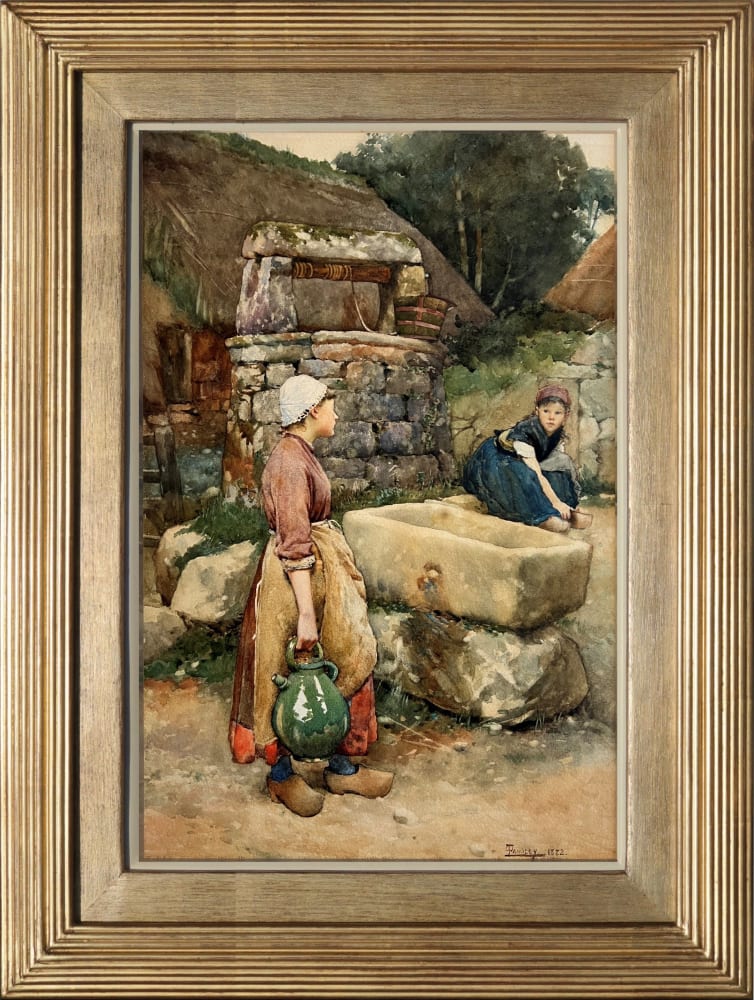
The Water Carrier (1882) by Walter Langley

The Water Carrier (1882) by Walter Langley - detail
Walter Langley 1852-1922
Framed: 74.3 x 55.2 cm (29 1/4 x 21 3/4 ins)
Further images
Provenance
The Harborne Collection.
With The Priory Gallery, Broadway.
Exhibitions
The Priory Gallery, Broadway.Dated 1882 and set in Brittany, The Water Carrier is a beautifully composed work executed in a period when Walter Langley was already in the process of settling in Newlyn. The work is catalogued by Langley's biographer, Roger Langley, as being part of the Alldays commission in 1882, which enticed Langley to commit to his pioneering move to Newlyn.
In 1880 Langley had first visited Newlyn. Impressed by the painting opportunities presented, he followed this inaugural trip with a second visit a year later plus importantly, in the context of the present work, a trip to Brittany. It was during that Breton trip that The Water Carrier was commenced although quite possibly completed in Newlyn. The green water jar belonged to Langley and appears in other works such as A Breton Girl, 1881 (ref: Walter Langley - Pioneer of the Newlyn Art Colony, p56). Unlike many of his Newlyn peers Langley was not blessed with a wealthy family that could support an artist’s apprenticeship in the ateliers of Paris or Antwerp. So this spell in Britany in 1881-82 was formative, exposing Langley to the influence of Jules Bastien-Lepage and life in a colony surrounded by young like-minded artists. His Birmingham friend and companion in Brittany, Edwin Harris, described the colonies as 'swarmed (with) English, French, Americans and representatives of almost all nationalities'. Many of these young aspiring artists would have had the benefit of tuition in the Parisien studios absorbing the en plein air approach and social realist subject matter expounded by Lepage. The latter in particular resonated with Langley.
In The Water Carrier we also witness an early demonstration of Langley’s empathy with women and the hardship and gender inequality that they endured. In a short amount of time this social realism and sensitivity towards the plight of women was to be given full volume in works filled of pathos and sometimes tragedy such as Among the Missing (1884). But in The Water Carrier it is expressed simply and more innocently through the arduous task of collecting water from a well in a heavy earthenware jug. An amusing respite is afforded by the younger girl who quite clearly isn’t helping at all. We can only imagine what her older companion is saying to implore her assistance.
-
 Walter LangleyA Nautical Question, 1882Watercolour & Body colour on paper35.5 x 25.4 cm (14 x 10 ins.)
Walter LangleyA Nautical Question, 1882Watercolour & Body colour on paper35.5 x 25.4 cm (14 x 10 ins.)
Framed: 57.0 x 47.6 cm (22.4 x 18.7 ins.) -
 Walter LangleyThe Marriage Column, c. 1900Watercolour & Body colour on paper48.3 x 27.9 cm (19 x 11 ins.)Sold
Walter LangleyThe Marriage Column, c. 1900Watercolour & Body colour on paper48.3 x 27.9 cm (19 x 11 ins.)Sold
Framed: 67.4 x 46.3 cm (26.5 x 18.2 ins.) -
 Walter LangleyThe News, Newlyn Harbour, 1903Watercolour and body colour on paper59.5 x 43.8 cm (23 1/2 x 17 1/4 ins)
Walter LangleyThe News, Newlyn Harbour, 1903Watercolour and body colour on paper59.5 x 43.8 cm (23 1/2 x 17 1/4 ins)
Framed: 82.5 x 66.7 cm (32 1/2 x 26 1/4 ins)








